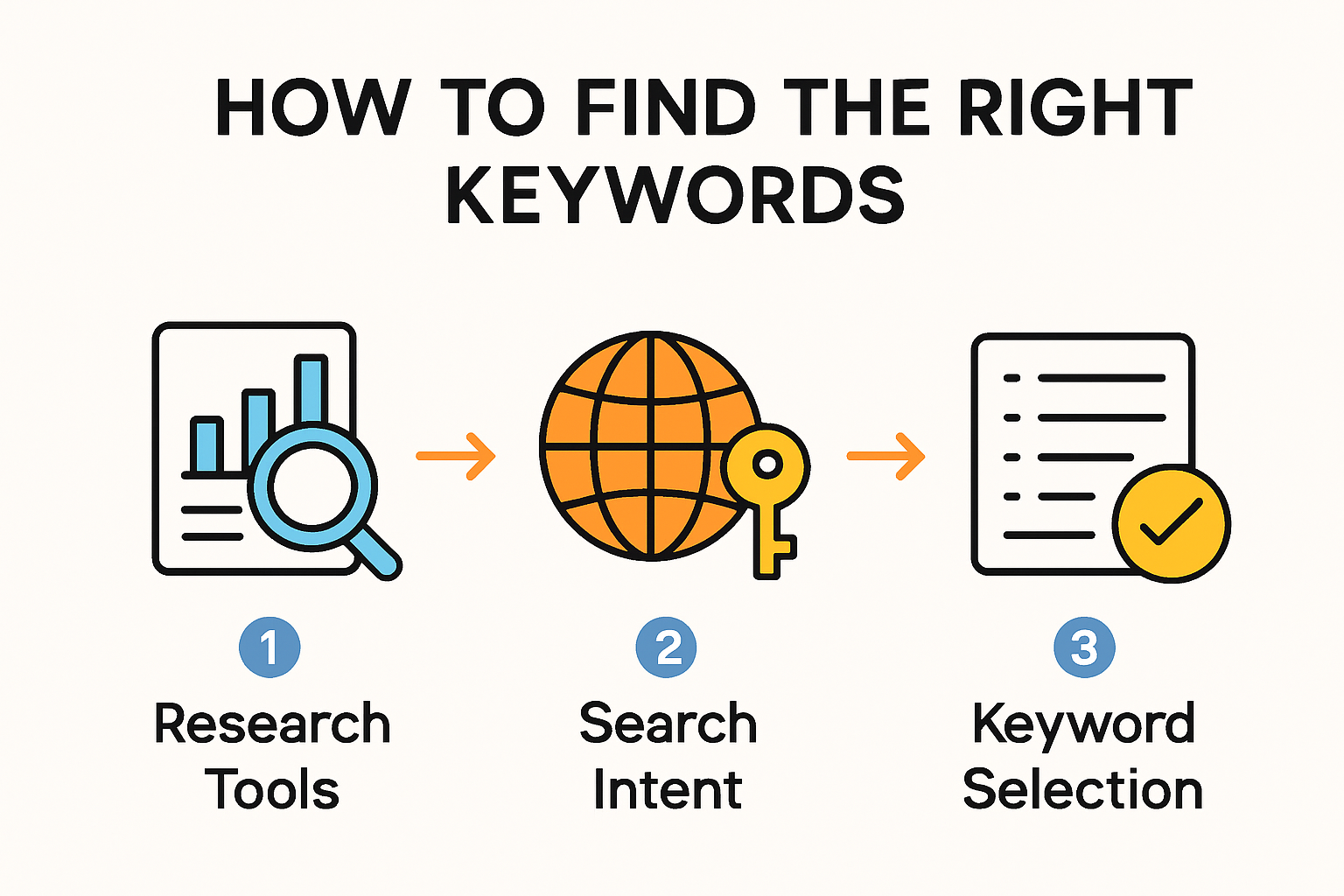Keyword Optimization Techniques for Higher Rankings

 Keyword optimization is crucial for improving your online visibility in a crowded digital space. Surprisingly, effective keyword strategies can increase organic traffic by up to 50 percent. Yet, many still think simply picking popular words will do the trick. The truth is, the real magic happens when you perfectly align keywords with user intent and content relevance.
Keyword optimization is crucial for improving your online visibility in a crowded digital space. Surprisingly, effective keyword strategies can increase organic traffic by up to 50 percent. Yet, many still think simply picking popular words will do the trick. The truth is, the real magic happens when you perfectly align keywords with user intent and content relevance.
Table of Contents
- Understand Keyword Optimization Basics
- Find The Right Keywords Easily
- Apply Keywords On Your Pages
- Measure Your Results Effectively
Quick Summary
| Takeaway | Explanation |
|---|---|
| Understand Keyword Research | Comprehensive keyword research is essential for identifying terms your audience uses, including long-tail keywords and understanding search intent, which guides effective content creation. |
| Strategic Keyword Placement | Proper keyword integration requires placing them in critical locations such as page titles, first sentences of content, and meta descriptions while avoiding keyword stuffing for optimal readability. |
| Measure Performance Metrics | Tracking performance metrics like CTR, organic traffic, and conversion rates provides insights into the effectiveness of your keywords and informs strategic refinements. |
| Continuous Improvement | Regularly review and adapt your keyword strategies based on performance metrics and search algorithm changes to maintain visibility and relevance in search results. |
Understand Keyword Optimization Basics
Keyword optimization is the strategic process of selecting and using specific words and phrases that help your content rank higher in search engine results. Unlike random word selection, this technique requires careful research, analysis, and implementation to connect your content with potential audience searches.
The Core Purpose of Keyword Optimization
At its fundamental level, keyword optimization serves as a bridge between user search intent and your digital content. When done correctly, it ensures that search engines can easily understand and categorize your content, making it more likely to appear in relevant search results. According to Moz's SEO research, websites that strategically implement keyword optimization can see significant improvements in organic search visibility.
Effective keyword optimization goes beyond simply stuffing content with popular terms. It involves understanding user language, search patterns, and the contextual relevance of specific words. Successful digital marketers recognize that keyword optimization techniques are about creating meaningful connections between search queries and valuable content.
Strategic Keyword Research and Selection
The foundation of successful keyword optimization lies in comprehensive research. This process involves identifying the specific words and phrases your target audience uses when searching for information related to your content. Research from Carnegie Higher Education suggests starting with a brainstormed list of priority subjects and systematically ranking potential keyword opportunities.
Key steps in keyword research include:
- Analyzing search volume and competition for potential keywords
- Understanding user intent behind specific search terms
- Identifying long-tail keywords that offer more specific targeting
- Evaluating the relevance of keywords to your specific content or business niche
Implementing Keywords Strategically
Properly integrating keywords requires a nuanced approach. According to research published in the National Center for Biotechnology Information, effective keyword optimization involves placing targeted terms in critical locations such as:
- Page titles
- First two sentences of content
- Subheadings
- Meta descriptions
- Image alt text
The goal is natural integration that enhances readability while signaling relevance to search engines. Avoid keyword stuffing, which can actually harm your search rankings. Instead, focus on creating high-quality, informative content that seamlessly incorporates your chosen keywords.
Successful keyword optimization is an ongoing process. Search trends evolve, user behaviors change, and search engine algorithms continuously update. Digital marketers and content creators must remain adaptable, regularly reviewing and refining their keyword strategies to maintain optimal search performance.
Find the Right Keywords Easily
 Discovering the right keywords is not a mystical art but a systematic process that can be mastered with the right tools and strategies. Digital marketers and content creators need a structured approach to identify keywords that genuinely connect with their target audience and improve search engine visibility.
Discovering the right keywords is not a mystical art but a systematic process that can be mastered with the right tools and strategies. Digital marketers and content creators need a structured approach to identify keywords that genuinely connect with their target audience and improve search engine visibility.
Leverage Powerful Keyword Research Tools
Modern keyword research has been revolutionized by advanced digital tools that provide deep insights into search behaviors. Google Keyword Planner remains a foundational resource, offering comprehensive data about search volumes, competition levels, and potential keyword variations. Additionally, tools like SEMrush and Ahrefs provide more nuanced insights into keyword performance and competitive landscapes.
Key advantages of using professional keyword research tools include:
- Discovering long-tail keyword opportunities
- Understanding search intent behind specific queries
- Analyzing competitor keyword strategies
- Tracking keyword difficulty and potential ranking challenges

Understand Search Intent and User Behavior
Successful keyword optimization goes beyond mere statistical analysis. According to research from the University of Georgia, understanding the underlying search intent is crucial. Keywords can be categorized into several intent types:- Informational Keywords: Users seeking knowledge or answers
- Navigational Keywords: Users looking for a specific website or page
- Transactional Keywords: Users ready to make a purchase or take action
- Commercial Investigation Keywords: Users comparing products or services
By mapping keywords to specific user intents, content creators can develop more targeted and effective keyword optimization techniques that genuinely resonate with their audience.
Practical Keyword Selection Strategies
Research from Wiley Publishing suggests a systematic approach to keyword selection. Start by brainstorming core topics related to your content, then expand using research tools to identify related search terms.Effective keyword selection involves:
- Analyzing search volume and competition
- Checking keyword relevance to your specific niche
- Balancing between high-volume and low-competition keywords
- Considering geographic and demographic variations in search behavior
Remember that keyword optimization is not a one-time task but an ongoing process. Search trends evolve rapidly, and successful digital strategies require continuous monitoring and adaptation. Regularly revisit your keyword strategy, track performance metrics, and be prepared to adjust your approach based on emerging search patterns and audience behaviors.
Apply Keywords On Your Pages
Successful keyword integration is an art of balance, requiring strategic placement and natural incorporation throughout your digital content. Simply inserting keywords randomly can harm your search rankings, making a thoughtful approach crucial for effective keyword optimization techniques.
Strategic Keyword Placement
Research from Carnegie Higher Education emphasizes that keyword placement must align with user intent and maintain contextual relevance. This means carefully embedding keywords in locations that both search engines and human readers find meaningful.Primary keyword placement locations include:
- Page titles
- First 100 words of content
- Headings and subheadings
- Meta descriptions
- Image alt text
- URL structure
Maintaining Natural Content Flow
According to Wiley's SEO guide, keywords should be integrated seamlessly without disrupting readability. The goal is creating content that feels natural while simultaneously signaling relevance to search algorithms.
Key principles for natural keyword integration:
- Use variations of your primary keyword
- Avoid keyword stuffing
- Prioritize reader comprehension
- Ensure contextual coherence
Technical Optimization Techniques
University of Georgia research highlights that technical optimization extends beyond content placement. Modern keyword optimization techniques involve structured data, semantic understanding, and comprehensive page optimization.Technical optimization strategies include:
- Creating descriptive, keyword-rich URLs
- Using header tags (H1, H2) strategically
- Implementing schema markup
- Optimizing page load speeds
- Ensuring mobile responsiveness
Remember that keyword optimization is an ongoing process. Search engine algorithms continuously evolve, demanding regular content review and refinement. Digital marketers must remain adaptable, monitoring performance metrics and adjusting strategies to maintain optimal search visibility.
Measure Your Results Effectively
Measuring keyword optimization performance is not just about tracking numbers, but understanding the nuanced impact of your keyword optimization techniques on overall digital marketing success. Effective measurement provides actionable insights that guide strategic refinements and improve content visibility.
Essential Performance Metrics
Research from Markitors suggests that comprehensive keyword performance measurement requires analyzing multiple interconnected metrics. Digital marketers should focus on key performance indicators that provide holistic insights into keyword effectiveness.Critical metrics to track include:
- Click-through rate (CTR)
- Search engine rankings
- Organic traffic volume
- Conversion rates
- Time spent on page
- Bounce rates
Each metric offers a unique perspective on how well your keywords are connecting with your target audience and driving meaningful engagement.
Advanced Analytics Strategies
The ARF Research Report highlights that sophisticated keyword performance analysis goes beyond surface-level metrics. Successful digital marketers must develop a nuanced understanding of content relevance and domain authority.Advanced measurement techniques involve:
- Comparing content relevance against competitor websites
- Analyzing keyword alignment with user search intent
- Tracking incremental improvements in organic visibility
- Evaluating long-term keyword performance trends
- Identifying potential optimization opportunities
Continuous Improvement Framework
Keyword optimization is an iterative process that demands ongoing attention and refinement. Google Analytics and other professional tools provide comprehensive dashboards that enable real-time performance tracking and strategic adjustments.
Key principles for continuous improvement include:
- Regularly reviewing performance metrics
- Experimenting with keyword variations
- Staying updated on search engine algorithm changes
- Adapting strategies based on data-driven insights
- Maintaining a flexible approach to keyword optimization techniques
Successful digital marketers understand that keyword measurement is not a one-time task but a continuous journey of learning and adaptation. By developing a robust measurement framework, you can transform raw data into strategic insights that drive meaningful improvements in search engine performance and audience engagement.
Frequently Asked Questions
What is keyword optimization?
Keyword optimization is the process of selecting and using specific words and phrases to improve content ranking in search engine results, ensuring relevance to user search intent.
How can I conduct effective keyword research?
Start by brainstorming core topics related to your content, then use keyword research tools like Google Keyword Planner, SEMrush, or Ahrefs to identify search volume, competition, and long-tail keyword opportunities.
What are long-tail keywords and why are they important?
Long-tail keywords are specific phrases consisting of three or more words that target niche audiences. They usually have lower competition and higher conversion rates, making them effective for reaching potential customers.
How can I measure the effectiveness of my keyword optimization?
Track essential performance metrics such as click-through rate (CTR), organic traffic volume, and conversion rates using tools like Google Analytics to understand how well your keywords are performing.
Unlock Your SEO Potential with BabyLoveGrowth.ai
Are you struggling with keyword optimization to boost your online visibility? If your content isn’t aligning with user intent, you might be missing out on valuable traffic and engagement. Many businesses grapple with identifying effective keywords or integrating them seamlessly into their content. Don’t let your competitors outrank you! Harnessing the power of optimized keywords can increase your organic traffic by up to 50 percent!

At BabyLoveGrowth.ai, we transform the way you approach SEO. Our automated content generation is tailored to your business needs, ensuring that your keywords are effectively optimized for both search engines and user intent. With our three-step process—in-depth analysis, a customized 30-day content plan, and automatic article generation—you’ll not only save time but also enhance your online presence effortlessly.
Ready to optimize your keyword strategy and watch your rankings soar? Visit https://babylovegrowth.ai now and give your business the visibility it deserves!
Recommended Articles
Smart SEO,
Faster Growth!
Most Read Articles

Generative Engine Optimization (GEO)
Learn how Generative Engine Optimization (GEO) helps your content rank in AI search engines like ChatGPT and Google AI. This comprehensive guide explains the differences between SEO and GEO, why it matters for your business, and practical steps to implement GEO strategies for better visibility in AI-generated responses.

Track LLM Traffic in Google Analytics 4 (GA4)
Learn how to track and analyze traffic from AI sources like ChatGPT, Claude, Perplexity, and Google Gemini in Google Analytics 4. This step-by-step guide shows you how to set up custom filters to monitor AI-driven traffic and make data-driven decisions for your content strategy.

How to Humanize AI Text with Instructions
Learn practical techniques to make AI-generated content sound more natural and human. This guide covers active voice, direct addressing, concise writing, and other proven strategies to transform robotic text into engaging content.

Open AI Revenue and Statistics (2024)
Comprehensive analysis of OpenAI financial performance, user engagement, and market position in 2023. Discover key statistics including $20B valuation, $1B projected revenue, and 100M+ monthly active users.